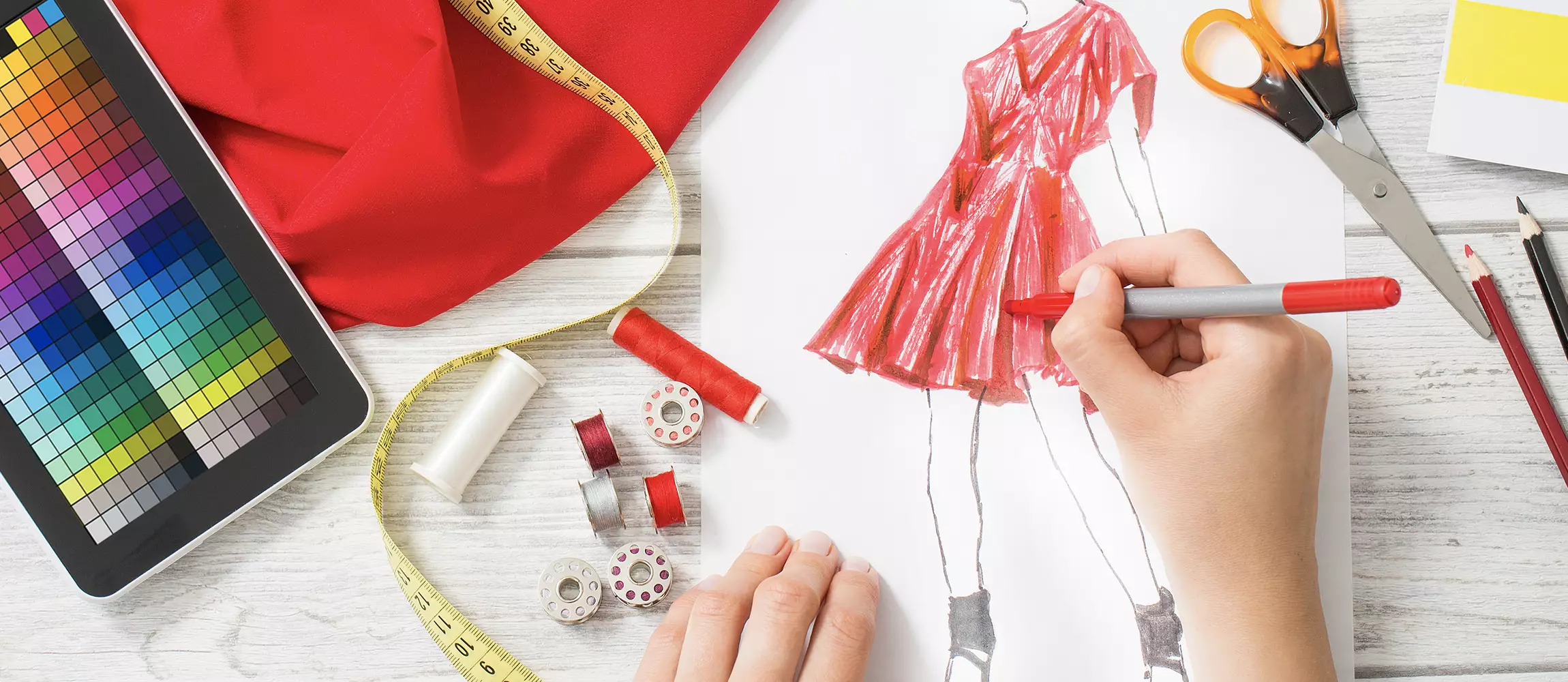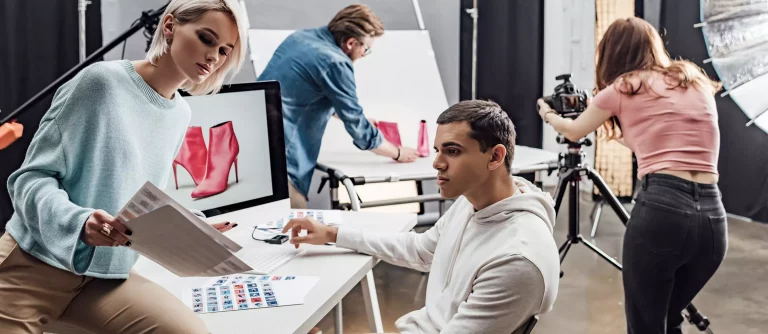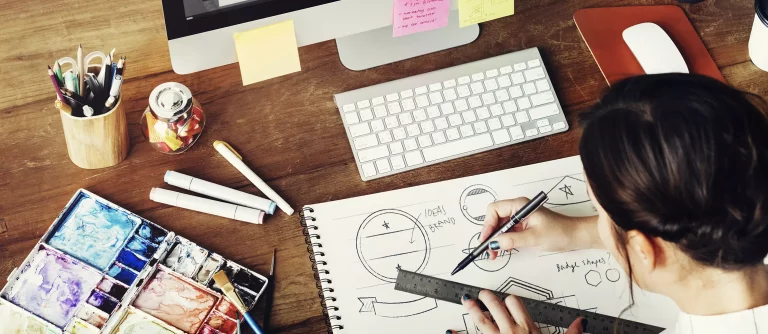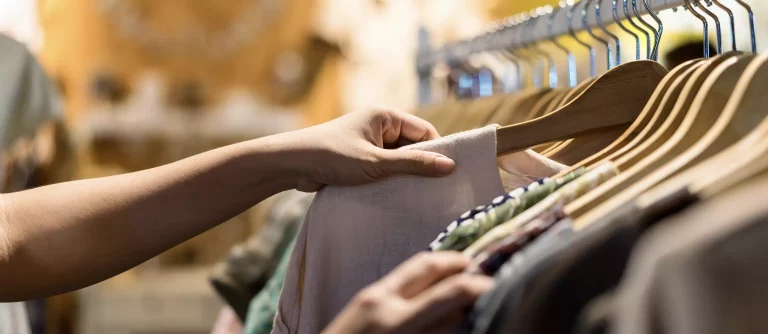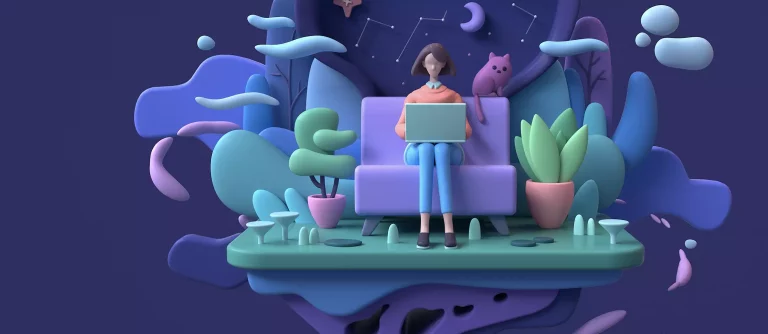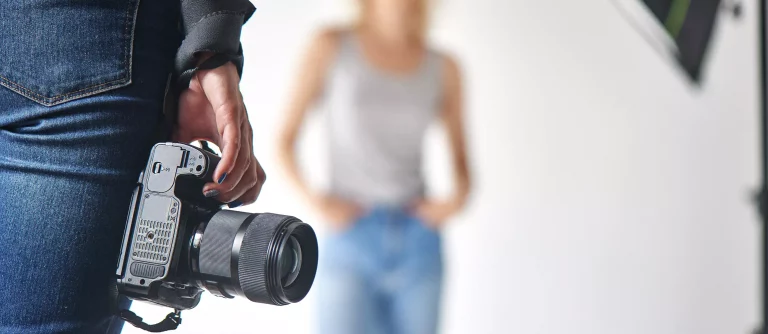How To Become A Fashion Designer
Do you want to learn how to become a fashion designer? In this guide, we’ll look at what this job involves, what kind of education you might need, and how to break into the industry. We’ll also answer some common questions that people have about this job.
What Is A Fashion Designer?
A fashion designer creates new designs and clothing patterns, either as original submissions to companies or at clients’ request to meet specific needs.
This is not the same thing as making clothes. Most fashion designers create at least a few clothes because knowing the construction process is fundamental to understanding if a design will work or not, but fashion designers are not always seamstresses.
Fashion designers work in many different industries, and the details of the jobs can change widely between different roles. For example, some fashion designers work in the film industry and help create original costumes for characters, while others focus on demographics like children’s apparel.
The design aspect of this job is the essential component. Clothes usually need to be both functional and visually appealing, so designers must consider details like the patterns, materials, colors, and current styles that people are buying. Some designers also calculate production costs and follow company guidelines for production budgets.
For digital garments, such as those in video games, the design is even more critical. Physical constraints don’t limit these, but the outfits need to match a coherent theme for the product they appear in.
Most fashion designers focus on one of these three categories:
Haute Couture
Haute couture (French for “high dressmaking” or “high sewing”) is the process of creating individual garments, typically custom-fit for a single person. Fashion designers with this role often sew the garments themselves, but some employ specialists or even entire workshops to turn their designs into reality.
French fashion design has some limits on the use of the term, but it’s widely used outside of that country to refer to exclusive, high-end design. This is the most luxurious form of fashion design, so it pays the best and is much harder to get into than any other role.
Fashion designers who focus on haute couture usually need to find clients who can show off their clothes and attract more customers. Many haute couture works are advertisements to show off the skill of the person or company behind it, usually leading to mass production of other, simpler outfits.
Ready-To-Wear
Ready-to-wear design is the middle level of fashion design. This area focuses on a relatively small number of products that sell for a high price, and many luxury brands ultimately fall into this category.
Since these garments need to fit various potential buyers, the construction aspect of fashion design is critical. Many designs allow for some level of adjustment to fit the individual wearer. Ready-to-wear items can be creative but often trend towards simplicity with one or two highlights to catch the eye.
High Street
Despite the name, high street fashion design doesn’t refer to luxury brands. Instead, this focuses on mass-market appeal, with budgets being the essential factor in creating them. However, while these garments sell for less, that doesn’t diminish the importance of good fashion design.
Rather, it’s the other way around. Creating designs that allow for good clothing at minimal complexity and production costs takes a significant amount of skill, especially because there’s almost no margin for error. While this isn’t as glamorous as haute couture, it’s a viable career path as a fashion designer.
What Does A Typical Workday For A Fashion Designer Look Like?
Hours vary by company, but most fashion designers work regular company hours, with some overtime being common ahead of fashion shows or making samples. Some fashion designers spend a lot of overtime creating garments to help stay ahead of the competition.
Fashion design is doable almost anywhere globally, but most people in this field concentrate near the major global fashion hubs. These include London, New York City, Paris, and Rome for the American and European areas and Tokyo, Dubai, Singapore, Seoul, and Hong Kong in the Middle East and Asian regions.
Days often start with meetings to gather information and ideas. Fashion designers are highly collaborative and often work with marketers, production managers, and other individuals while creating designs.
Fashion designers also spend a lot of time forecasting future trends. Most fashion designers work about two seasons ahead of time, and accurately predicting the market is essential to success. For example, you may design clothes in winter so they can be produced in spring and sold in summer.
This timeline applies mainly to ready-to-wear and high street houses. Haute couture designers may work primarily on clients’ requests, which have a much shorter turnaround than mass-produced clothes do.
Will I Like Being A Fashion Designer?
Fashion design isn’t for everyone. The hours can be long, and the need to balance creativity with a fast-paced work environment can be challenging. That said, fashion designers frequently travel to fashion hubs, so this field has some great perks to enjoy. Here’s what you should know about your chances of enjoying a career as a fashion designer.
Characteristics And Skills Of A Good Fashion Designer
These are the main characteristics and skills of fashion design.
- Creativity: This is one of the most important aspects of fashion design. Creativity applies not just to your personal sense of art but also to understand what clients are looking for and how to bring their garments to life. Creativity in fashion design can also apply to construction techniques, material choices, and so on.
- A Discerning Eye: Fashion designers need a great eye for judging colors, patterns, and textures to estimate how they’ll look on a finished garment. Most clothes need to look stylistically sound from any angle, and that’s much harder than it looks.
- Visualization: Visualizing garments in three dimensions, and editing them with your mind’s eye, is a key part of the design process. People who are unable to visualize things, such as anyone with aphantasia, may have a much harder time in this field. That said, software can compensate for this ability, so visualizing skills aren’t mandatory.
- Drawing Skills: Fashion designers must communicate their designs to other people. For many, this involves drawing complex fashion designs on paper. Some people use digital software for drawing instead. Some companies may only hire designers who can produce designs in particular ways.
- Time Management: Fashion design is a fundamentally creative job, but it also requires the ability to manage your time well and finish creating things by particular deadlines. This is especially important when company travel can upset time you’d normally spend working. Many fashion designers work overtime as needed.
- Communication Skills: Fashion designers often spend time explaining their concepts, receiving feedback, and editing designs as appropriate. The willingness to accept feedback, and compromise artistic vision for budgeting or production reasons, is also important for this role.
- Organizational Skills: Many people think of artists as scatterbrained or lost in their own heads, although the truth is that most fashion designers are simply busy creating mental images of potential products. Organizational skills, ranging from time management to storing created assets, are therefore extremely useful.
Other fashion designers need specific skills, depending on the job. For example, fashion designers working for television shows may need to research period-appropriate clothing to match where the show will take place. Some may even need to adjust garment designs to meet specific needs for actors, such as hiding tattoos or props.
Why You Might Not Like Being A Fashion Designer
As you can see above, successful fashion designers tend to be creative and social, with the ability to work on tight deadlines and coordinate with others as needed. However, there are some downsides to this job as well.
First, being a fashion designer requires constant, time-sensitive work. The need for regular overtime at most locations can make it hard to spend time creating garments solely for the love of the art, though you can often reduce the amount of overtime needed as you get better in your role.
Second, most fashion designers have many limits on their creativity. Not even counting time deadlines, these include budgets, material choices, and even who you expect to be wearing them. Designing a dress for a petite woman is quite different from making an outfit for a male bodybuilder.
Finally, fashion designers don’t always make a lot of money in this job. Newcomers may only make a little more than needed to pay expenses, although senior designers tend to live comfortable lives. This is mitigated somewhat by regular travel opportunities, but luxury designers don’t always live luxury lives.
Typical Schooling For A Successful Fashion Designer
Fashion designers typically start young in the United States, with a childhood focus on art and design. Most employers have minimum degree requirements for designers, but schools often relax their requirements for any candidate who has sufficient experience in this field.
Degree Type, Certifications, Classes, Years Of Schooling, Etc.
Fashion designers should have at least a bachelor’s degree, preferably in a relevant area of design. It helps to choose which type of garments you want to focus on early in your education. Most fashion designers dream of doing haute couture, but settling for ready-to-wear or high street garments can significantly increase your chances of getting a job.
Outside of education, fashion designers need experience. Companies strongly value designers who have some experience with producing things on deadlines and to specific budgets. Real-world experience is arguably more important than schooling, especially if you can show off several products you’ve already released.
Many fashion designers take part in shows or competitions that help sell new designs. In this sense, understanding your audience is what gets your foot in the door, rather than your degree alone.
Best Fashion Design Colleges
Here are some of the best fashion design schools. In-person schools are objectively better for developing your skills and getting noticed, but online schools are an option if that’s the only way you can attend.
Top In-Person Schools
Here are some of the top physical fashion design colleges:
Parsons
Parsons is a top-tier fashion design school in New York, and the programs also include fashion studies and marketing. Tuition is about $40,000 annually but comes with many retail and corporate partnerships that help improve your odds of getting noticed.
Fashion Institute of Technology
The Fashion Institute of Technology, or FIT, is part of the State University of New York. While it doesn’t have the same types of connections as Parsons, it offers high-quality classes at significantly lower tuition. Expect to pay around $14,000 a year for classes there or much less if you’re a New York state resident.
Pratt
Located in Brooklyn, New York (seeing a pattern here?), Pratt has tuition similar to Parsons, and it has a flexible design program that includes many other arts. This is a great way to combine some studies. Pratt also hosts high-end student shows that help with getting noticed by major brands, so it’s a good way to break into the industry.
Top Online Schools
Here is a list of the top virtual schools to learn fashion design:
Liberty University
Liberty University is a private school with a wide variety of programs, including a robust fashion design program. Tuition is usually $12,000 (or less, for graduate programs), but note that this is a Christian religious school that impacts their degree requirements.
Southern New Hampshire University
SNHU is a little more affordable than Liberty University, with annual tuition closer to $9,600. It also has a relatively high rate of recommendation, which helps it stand out from its closest competitors.
Old Dominion University
ODU is a highly-recommended doctoral research university, and its online programs are just as robust as its in-person options. Fashion design is a fundamentally forward-looking field, so ODU’s focus on this can help develop your skills in the right focus.
However, ODU is noticeably more expensive than Liberty University or SNHU, with tuition of close to $30,000. It’s a great school on the merits, but not the most budget-friendly if you want to study online as a cost-saving measure.
Can I Skip College And Teach Myself How To Be A Fashion Designer?
Yes, it is possible to become a fashion designer without going to college. It’s certainly harder because you won’t have the advantage of getting noticed in fashion shows while you’re in school, but it is possible.
Most companies care mainly about skill and experience, with college being a useful-but-optional third place in their evaluations. Here’s why.
Skill is the most important part of getting the job done. Some companies are willing to hire and train amateur designers. If you’re starting your career in the industry, this is a great place to begin because it will teach you more about the business side of things.
As we mentioned above, however, many fashion designers work on relatively tight schedules. It takes time to produce garments and ship them around the world in time for the intended retail dates, so the ability to get the job done in the first place is the single most critical factor.
Experience is a close second to skill because experienced fashion designers are, by definition, more familiar with the ins-and-outs of the process. This means fewer time-consuming mistakes and generally better designs.
Experience comes in many forms, but the most valuable are those where you can produce work on a short timeframe and within a predetermined budget. Winning fashion shows and the like is useful for getting noticed but not as helpful as experience that mimics real-world business needs.
3 Non-Traditional Paths To Become A Fashion Designer
Saying that a path is “non-traditional” is a bit of a misnomer. At this point, almost any route you can think of is largely standardized in that people understand the basic process. That said, there are a few distinct routes besides going to fashion school, then getting hired as an entry-level designer at a small or mid-sized company.
(Larger companies, incidentally, prefer experienced designers. It’s much harder to get a job there when you’re first starting out, especially because the competition is fiercer.)
Start Your Own Business
If you can both design and sew clothes, you can start your own business as a fashion designer. This requires excellent managing skills on top of design and sewing skills, so you’ll need to devote an extraordinary amount of time to it. However, if you can get enough clients to keep going, this experience can drastically increase your value if you want to work elsewhere later on.
Get An Internship
Internships aren’t as attractive as going straight into a design position, but they’re a great way to develop the kind of experience that employers look for. Contrary to popular belief, you don’t need to be a college student to get an internship as a fashion designer. However, you will need some fundamental skills, so expect to spend years studying on your own first.
Study Graphic Design
This is mainly for creating digital clothing, such as the type used in video games or CGI movies. Instead of creating physical garments, you can study rendering and asset modeling to become a digital fashion designer and create often-fantastical clothes.
This is a good route to consider if you particularly love the creative design aspect of being a fashion designer and want to work more on the ideas of clothes than the practical construction thereof.
Many companies love having digital assets that look good, whether superimposed on a human actor or a digital avatar, so a background in fashion design can set you apart from other digital artists.
Which Software Programs Do Fashion Designers Use?
Here are some of the top programs that fashion designers use:
Adobe Illustrator
Fashion designers do a lot of digital modeling these days, and Adobe Illustrator is the standard. It can work with everything from sketching to creating patterns and superimposing logos. Many fashion designers use Illustrator alongside Adobe’s even more popular Photoshop software.
Autodesk Sketchbook
Autodesk isn’t quite as well-known as Adobe, but it’s close. Their sketchbook software supports both stylus and touch drawings, and it’s ideal for creating artistic renderings of your concepts that you can then translate into sewing patterns or digital designs.
C-Design Fashion PLM
C-Design’s Product Lifecycle Management software for fashion is mainly a business program rather than a creative one. It imports images from software like Adobe Illustrator, then allows you to set product specifications and record other relevant data.
Digital Fashion Pro
Digital Fashion Pro is a business-oriented design suite that focuses on fabrics and prints. Notably, it includes different model poses so you can see how outfits will work in different situations. It also supports designing accessories like handbags and shoes, which some employers may want from you.
Wild Ginger Cameo
This software breaks the mold by having a name that explains almost nothing of what it does. The Wild Ginger’s Cameo Apparel Pattern software (on its 7th version at the time of writing this) is a pattern development software specifically designed for creating all types of custom outfits.
It includes drafting and editing, custom sizes and grades, and numerous modules that allow you to customize the software with only the parts you need. Most companies will expect you to use this, or something like this that they provide, so the experience is useful.
What Are The Best Blogs And Influencer Accounts To Follow?
We don’t have the space to discuss every blog or influencer you should follow. Celebrities like Selena Gomez offer an outstanding start, but the best thing you can do is look for blogs and influencers who work on the types of outfits you want to design.
In short, if you want to create brands for teens, look at teen-oriented blogs. If you want to make dresses for Hollywood celebrities, look at people in that area instead. Don’t be afraid to look internationally, either, because a great fashion designer doesn’t need to know a foreign language to understand a foreign outfit.
Finally, be sure to follow a few people outside of your circle. Seeing new things is a key part of maintaining your creativity and synthesizing designs, so you should actively seek out new looks, places, and experiences.
5 Ways To Break Into The Fashion Design Industry
Getting into the fashion design industry can be challenging. It’s relatively competitive, so if you can’t find a way to stick out, you won’t get too far. Here are some ways to help you break into the industry.
Get Online
A portfolio website is a great way to showcase your designs and what you can do. Website builders like WordPress and Squarespace can help you create great-looking sites, while things like Shopify can even help you sell your clothes.
Fashion design is extremely visual, so focus on photos or drawings instead of text. However, with that in mind, consider providing basic information like the design time and production budget. This will help potential employers know that you understand the business aspect of fashion design, which is what they care about.
Get Social
Joining websites like LinkedIn and Instagram isn’t just a way to chat with other people. Designers will often look for you on these sites so they can get a better evaluation of you, and such sites are a great place to showcase your designs and experience. You don’t need to spend every moment on social media, but try to post every day or two.
Become an Apprentice
Apprenticeships, when available, are a fantastic way to get experience. They can also help you form connections with companies that are looking to hire junior designers. If you don’t have any experience by the time you’re done with schooling, look for apprenticeships.
Also, remember that apprenticeships are not the same as internships. Apprentices can do more than interns, so you’ll get more hands-on experience this way.
Continue Learning
Never stop learning. Fashion is always changing, so if you only focus on your earliest designs and ideas, you won’t succeed as a fashion designer. Whether it’s new sewing techniques, new patterns, or simply taking lessons on the latest design software, make sure you commit to continuing your education.
Keep Grinding
Finally, chances are you’ll fail early in your career. You may have a hard time landing a junior position somewhere, or you may even drop out of college for one reason or another. Failures are an opportunity to learn, though, so figure out what went wrong and keep trying.
Many fashion designers fail all the time. It’s the commitment to keep going that sets successful designers apart.
FAQ
Here are some of the most common questions that people ask about working as a fashion designer.
How Much Money Do Fashion Designers Typically Make?
Fashion designers usually make moderately-average salaries in nations like the United States. Many will make somewhere between $46,000 and $92,550, which is certainly enough to support a comfortable lifestyle.
Two major factors affect how much you can expect to earn as a fashion designer. First, experience matters. Designers with decades of experience tend to make significantly more money because they have a long record of success and enough experience to produce designs the ways that businesses need.
Second, some companies simply pay better than others. Luxury brands usually pay fashion designers extremely well, even if payments are only commissions. Cheaper boutiques can’t offer as much, though they’re also easier to get into.
What Do You Study To Be A Fashion Designer?
Good fashion designers study as much as they can. Everything from history to foreign culture can help impact the designs for new clothing on multiple levels. Whether it’s ancient sewing techniques or materials used for coloring clothes, knowledge is one of the essential parts of designing new clothes.
Great fashion designers take it a step further. If you know how to source materials, how to get better prices on bulk orders, and how to coordinate with marketers, you’ll do even better than regular fashion designers. In short, you should aim to learn as much as you can about every step of the clothing production process.
Is Fashion Designer A Good Career Choice?
Whether or not being a fashion designer is a good career choice depends on how you view the job. The United States employs about 28,000 people in this role, with some overseas nations also contributing a significant number of jobs in their countries.
Fashion designers tend to have urban lifestyles, so it can support an exciting, active, big-city experience. Fashion designers also travel regularly, particularly to attend trade shows, and that’s a nice perk.
Are There A Lot Of Job Openings For Fashion Designers?
No. As we mentioned above, there are only about 28,000 fashion designers in the United States. While this isn’t a tiny number of jobs, it’s far fewer positions than many other fields have. For comparison, there are about 200,000 dentists and 950,000 doctors.
Most people dedicate their entire careers to being fashion designers, so there aren’t too many positions open at a time. Realistically, most of those positions are with smaller firms, often ten people or less.
What’s The Best Website To Find Fashion Designer Job Listings?
Websites like SimplyHired, Indeed, ZipRecruiter, and StyleCareers are a good place to find fashion design jobs. However, don’t rely exclusively on job postings. Instead, try advertising yourself in other ways at the same time, including at trade shows, through your website, and even through contacting employers directly.
Fashion designer jobs tend to be competitive, so it’s important to pursue every opportunity instead of waiting for the perfect job to come along.
What Are Some Big Companies That Hire Fashion Designers?
Big companies that hire fashion designers tend to be national or international clothing retailers. Companies and brands like The North Face, J. Crew, and Tommy Hilfiger use in-house fashion designers for their brands.
Larger companies tend to focus on high street creations, so they heavily emphasize budgets and practicality. Haute couture and ready-to-wear designers work almost exclusively at smaller companies that cater to special interests.

